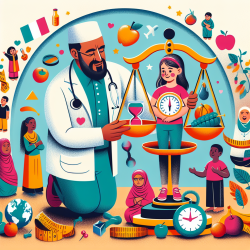Introduction
The COVID-19 pandemic has significantly impacted children's physical activity levels, particularly in economically disadvantaged communities. A recent study titled School Parks as a Community Health Resource: Use of Joint-Use Parks by Children before and during COVID-19 Pandemic sheds light on the role of joint-use parks in supporting children's health during challenging times. This blog explores how practitioners can leverage these findings to enhance their practice and promote better health outcomes for children.
Key Findings from the Research
The study conducted in Austin, Texas, observed children's use of joint-use parks before and during the COVID-19 pandemic. The results highlighted a significant decrease in park usage and physical activity levels among children during the pandemic. Specifically, there was a 46% decrease in the number of girls and a 62% decrease in boys using the parks. Additionally, adherence to COVID-19 protective behaviors, such as social distancing and mask-wearing, was low among children.
Implementing Research Outcomes in Practice
Practitioners working with children can utilize these findings to inform their interventions and strategies. Here are some actionable steps:
- Promote Safe Park Use: Encourage families to use parks safely by adhering to social distancing and mask-wearing guidelines. Provide clear communication and educational materials to raise awareness about the importance of these behaviors.
- Design Engaging Activities: Develop structured activities and programs that can be conducted safely in parks. These activities should cater to various age groups and interests to maximize participation and physical activity levels.
- Collaborate with Community Leaders: Work with local authorities and community organizations to ensure parks are accessible and safe for all children. Advocate for resources and policies that support equitable access to green spaces.
Encouraging Further Research
While this study provides valuable insights, there is a need for further research to explore the long-term impacts of the pandemic on children's health and park usage. Practitioners are encouraged to collaborate with researchers to gather data and develop evidence-based interventions that address the unique needs of their communities.
Conclusion
Joint-use parks hold great potential as community health resources, especially during challenging times like the COVID-19 pandemic. By implementing the research outcomes and encouraging further investigation, practitioners can play a crucial role in promoting healthier lifestyles and better health outcomes for children. To read the original research paper, please follow this link: School Parks as a Community Health Resource: Use of Joint-Use Parks by Children before and during COVID-19 Pandemic.










